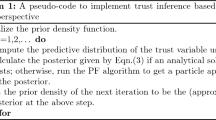Abstract
This paper elaborates on a solution to represent authorization and delegation in a graphical way, allowing users to better interpret delegation relationships. We make use of Weighted Trust Graph (WTG) as an instrument to represent delegation and authorization, extending it to cope with more complicated concepts, and providing a graphical representation of the level of confidence that exists between two entities regarding a resource or attribute. We represent the level of confidence for each pair of entities as a point in an axis diagram, as a set of points, or as a set of triangular regions depending on the accuracy we need. Then, we use the same diagram to represent the set of acceptable confidence level, that we call authorization policy set. In this way, a single diagram can be used to decide about authorization, thus providing a powerful tool for systems in which interaction of users is needed.
Preview
Unable to display preview. Download preview PDF.
Similar content being viewed by others
References
Agudo, I., López, J., Montenegro, J.A.: A representation model of trust relationships with delegation extensions. In: Herrmann, P., Issarny, V., Shiu, S.C.K. (eds.) iTrust 2005. LNCS, vol. 3477, pp. 116–130. Springer, Heidelberg (2005)
Li, N., Grosof, B.N., Feigenbaum, J.: Delegation logic: A logic-based approach to distributed authorization. ACM Trans. Inf. Syst. Secur. 6(1), 128–171 (2003)
Ruan, C., Varadharajan, V.: Resolving conflicts in authorization delegations. In: Batten, L.M., Seberry, J. (eds.) ACISP 2002. LNCS, vol. 2384, pp. 271–285. Springer, Heidelberg (2002)
Ruan, C., Varadharajan, V.: A weighted graph approach to authorization delegation and conflict resolution. In: Wang, H., Pieprzyk, J., Varadharajan, V. (eds.) ACISP 2004. LNCS, vol. 3108, pp. 402–413. Springer, Heidelberg (2004)
Ruan, C., Varadharajan, V., Zhang, Y.: Logic-based reasoning on delegatable authorizations. In: Hacid, M.-S., Raś, Z.W., Zighed, D.A., Kodratoff, Y. (eds.) ISMIS 2002. LNCS, vol. 2366, pp. 185–193. Springer, Heidelberg (2002)
Ruan, C., Varadharajan, V., Zhang, Y.: A logic model for temporal authorization delegation with negation. In: Boyd, C., Mao, W. (eds.) ISC 2003. LNCS, vol. 2851, pp. 310–324. Springer, Heidelberg (2003)
Author information
Authors and Affiliations
Editor information
Editors and Affiliations
Rights and permissions
Copyright information
© 2006 Springer-Verlag Berlin Heidelberg
About this paper
Cite this paper
Agudo, I., Lopez, J., Montenegro, J.A. (2006). Graphical Representation of Authorization Policies for Weighted Credentials. In: Batten, L.M., Safavi-Naini, R. (eds) Information Security and Privacy. ACISP 2006. Lecture Notes in Computer Science, vol 4058. Springer, Berlin, Heidelberg. https://doi.org/10.1007/11780656_32
Download citation
DOI: https://doi.org/10.1007/11780656_32
Publisher Name: Springer, Berlin, Heidelberg
Print ISBN: 978-3-540-35458-1
Online ISBN: 978-3-540-35459-8
eBook Packages: Computer ScienceComputer Science (R0)




